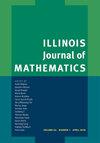有界区域内热方程解的导数的一个逐点不等式
IF 0.7
Q3 MATHEMATICS
引用次数: 3
摘要
设$u(t,x)$为$\mathbb{R}^n$中热方程的解。然后,每个$k-$次导数也能解出热方程并满足极大值原则,$u(t,x)$的最大$k-$次导数不能大于$u(0,x)$的最大$k-$次导数。我们用狄利克雷边界条件证明了有界域$\Omega \subset \mathbb{R}^n$上热方程解的一个类似命题。作为应用,我们给出了光滑域$\Omega \subset \mathbb{R}^n$上具有Dirichlet条件的拉普拉斯特征函数$-\Delta \phi_k = \lambda_k \phi_k$二阶导数急剧增长的一个新的相当初等的证明。本文章由计算机程序翻译,如有差异,请以英文原文为准。
A pointwise inequality for derivatives of solutions of the heat equation in bounded domains
Let $u(t,x)$ be a solution of the heat equation in $\mathbb{R}^n$. Then, each $k-$th derivative also solves the heat equation and satisfies a maximum principle, the largest $k-$th derivative of $u(t,x)$ cannot be larger than the largest $k-$th derivative of $u(0,x)$. We prove an analogous statement for the solution of the heat equation on bounded domains $\Omega \subset \mathbb{R}^n$ with Dirichlet boundary conditions. As an application, we give a new and fairly elementary proof of the sharp growth of the second derivatives of Laplacian eigenfunction $-\Delta \phi_k = \lambda_k \phi_k$ with Dirichlet conditions on smooth domains $\Omega \subset \mathbb{R}^n$.
求助全文
通过发布文献求助,成功后即可免费获取论文全文。
去求助
来源期刊
CiteScore
0.90
自引率
0.00%
发文量
18
期刊介绍:
IJM strives to publish high quality research papers in all areas of mainstream mathematics that are of interest to a substantial number of its readers.
IJM is published by Duke University Press on behalf of the Department of Mathematics at the University of Illinois at Urbana-Champaign.

 求助内容:
求助内容: 应助结果提醒方式:
应助结果提醒方式:


